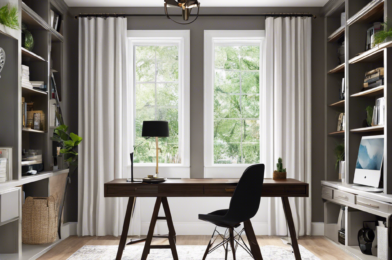Making your home more energy-efficient is a great way to reduce your environmental footprint and save money on your utility bills. There are many simple steps you can take to make your home more energy-efficient, and the benefits can be significant.
One of the easiest ways to improve your home’s energy efficiency is to upgrade to energy-efficient appliances. Look for the Energy Star label when purchasing new appliances, as these products are designed to use less energy and can save you money in the long run. Older appliances can be real energy hogs, so if you have the budget, consider upgrading to more efficient models. Even smaller changes, like switching to LED light bulbs, can make a big difference in your energy usage over time. These efficient bulbs can last for years and use a fraction of the energy of traditional incandescent bulbs.
Another important area to focus on is your home’s insulation and sealing. Proper insulation ensures your home retains heat during the winter and stays cool in the summer, reducing the need for excessive heating or air conditioning. Check your attic, basement, and walls for adequate insulation, and consider adding more if necessary. Sealing any gaps or cracks around doors and windows is also key to preventing air leaks and keeping your home comfortable. A well-insulated and sealed home not only improves energy efficiency but also enhances your overall comfort.
Additionally, consider investing in a smart thermostat. These devices allow you to control your home’s temperature remotely and can automatically adjust the temperature based on your schedule. This means you can turn down the heat or air conditioning when you’re away and have it turn back on before you return home, saving energy and money. Smart thermostats can also provide you with detailed energy usage reports, helping you identify areas where you can further reduce your consumption.
Another simple way to improve your home’s energy efficiency is to be mindful of your daily habits. Remember to turn off lights and appliances when you’re not using them, and unplug chargers and electronics to prevent “vampire power” drain. Also, try to use natural light whenever possible by opening curtains or blinds during the day. These small changes in behavior can add up to significant energy savings over time.
Making your home more energy-efficient can also involve bigger projects, such as installing solar panels or replacing old windows. Solar panels can harness the power of the sun to generate clean energy for your home, reducing your reliance on the traditional power grid. Meanwhile, outdated windows can be a major source of air leaks and poor temperature control, so upgrading to energy-efficient windows can make a noticeable difference. While these projects may require a larger upfront investment, they can pay off in the long term through reduced energy costs and increased home value.
It’s also worth looking into energy-efficient upgrades when making routine home improvements. For example, if you’re replacing your roof, consider using cool roof technology, which reflects sunlight and reduces heat transfer into your home. Or, when updating your landscaping, plant trees strategically to provide shade and help regulate your home’s temperature naturally. Integrating energy efficiency into your overall home maintenance plan can help you maximize your energy savings.
Lastly, educate yourself and your family about energy efficiency. Understanding how different systems in your home use energy and simple ways to reduce consumption can empower everyone to make a positive impact. This might include learning about the various settings on your appliances, researching energy-saving tips online, or even attending community workshops on sustainability practices. By staying informed and engaged, you can continue to find new ways to make your home even more energy-efficient.
By following these steps and making a few simple changes, you can significantly reduce your home’s energy consumption and lower your utility bills. Remember that even small adjustments can have a cumulative effect, so start with what you can and work towards a more energy-efficient and sustainable home. Your efforts will not only benefit the environment but also contribute to a more comfortable and cost-effective living space.









